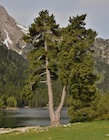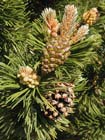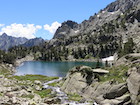Conservation Status

(subsp. uncinata)

(subsp. uliginosa)
Pinus uncinata
Ramond ex De Candolle 1805
Common names
Mountain pine, Swiss mountain pine, pin à crochets [French], Spirke [German], pino negro [Spanish]. Subsp. uliginosa is bog pine, Moor-Spirke [German], blatka or borovice blatka [Czech], or sosna blotna [Polish].
Taxonomic notes
Two subspecies:
- Pinus uncinata subsp. uliginosa (G.E.Neumann) Businský (2006). Type designated by Christensen (1987): Poland, Slask, Klodzko, Gory Stolowe - Mt. Szczeliniec, Radkdw, Wielkie Torfowisko Batorowskie, 5 Sep 1842, Reichenbach fil. s.n. (neotype W 1889-273942).
- Pinus uncinata subsp. uncinata. Type: Europe, K. I. Christensen F6, 5-12 July 1980 (neotype G).
Synonymy: POWO lists 96 synonyms, but by far the most common ones in recent literature are P. mugo subsp. uncinata (Ramond) Domin. (for subsp. uncinata) and P. mugo subsp. rotundata (for subsp. uliginosa).
There are also 6 named hybrids:
- Pinus × ascendens Businský is the hybrid of P. uncinata and P. mugo.
- Pinus × ascendens nothosubsp. ascendens is the hybrid of P. uncinata subsp. uncinata and P. mugo.
- Pinus × ascendens nothosubsp. skalickyi Businský is the hybrid of P. uncinata subsp. uliginosa and P. mugo.
- Pinus × rhaetica Brügger is the hybrid of P. uncinata and P. sylvestris.
- Pinus × rhaetica nothosubsp. digenea (Beck) K.Richt. is the hybrid of P. uncinata subsp. uliginosa and P. sylvestris.
- Pinus × rhaetica nothosubsp. rhaetica is the hybrid of P. uncinata subsp. uncinata and P. sylvestris.
This is a member of Pinus subsection Pinus, a large section comprised mostly of Eurasian 2-needle pines. See discussion on the P. mugo page. Its separation as a taxon distinct from P. mugo is based mainly upon its growth form as an erect tree, which is maintained regardless of the environment in which it is planted (except in the interior of peat bogs). The separation of the two subspecies is justified mainly "because the bog pine represents a very conspicuous population and ecological entity in the absence of intermediates between P. uncinata subsp. uncinata and the bog pine in Poland" (Businský 2006).
Description
Evergreen monoecious trees to 12-20 m tall and 50-100 cm dbh, with a straight, erect trunk and an ovoid-conic crown. Bark ash-gray-brown to blackish-grey, splitting in angular scaly plates, thick at base of trunk. Shoots uninodal, glabrous, greyish-black to deep red-brown grooved between the decurrent scale-leaves. Buds ovoid-conic, 6-9 mm, red-brown, very resinous. Leaves in fascicles of two (rarely three around apical bud of strong shoots), bright to dark green, often with a gray tinge, straight to slightly twisted, minutely serrulate, 23-75 × 0.9-2.1 mm, leaf sheath persistent, gray, 15-18 mm. Leaves persistent (2-)4-9(-10) years. Pollen cones 10 mm long, yellow or red, pollen shed May to July. Seed cones purple when receptive, ripening shiny dark brown in late September to October 15-17 months later and opening then or the following spring; sessile or nearly so, strongly asymmetrical, 25-60 mm long, 20-40 mm wide (closed), opening to 30-50 mm wide, deflexed down-stem with angle of inclination to stem 110°-160°; apophyses thick, strongly pyramidal on outer side of cone, still thickened and pyramidal on inner side but not strongly so, stiff, inflexible, 6-10 mm wide, outer scale apophyses 4-9 mm thick, inner apophyses 3-4 mm thick; umbo at apex of apophyses, 3-4 mm wide, often with a pronounced 1 mm prickle. Seed black, 3-4 mm with a 7-12 mm wing buff with darker streaks; cotyledons (3-)5-7(-8). Cones shed soon after seed release or up to a year or two later (Christensen 1987; note the foliage characters are identical to P. mugo, the taxa being separable only on habit and cone characters). See García Esteban et al. (2004) for a detailed characterization of the wood anatomy.
Comparing P. mugo and the two subspecies of P. uncinata (Jasinska et al. 2009, Sokołowska et al. 2021):
- P. mugo is a shrub with long, curved branches, reaching up to 3.5 m in height; also it is generally a high mountain species, found at 1600-2200 m elevation.
- P. uncinata subsp. uliginosa is usually a tree to 7 m tall, found in peat bogs.
- P. uncinata subsp. uncinata is a tree reaching at maturity 12–20 m tall.
Distribution and Ecology
Subsp. uncinata is in Andorra, Austria, France, Germany, Italy, Spain, Switzerland, with subsp. uliginosa in Austria, Czechia, Germany, Poland, and Ukraine (Jasinska et al. 2009). Mainly found in the Sierra de Gúdar, Sierra Cebollera, Pyrenees, Massif Central, and the western Alps. A high altitude species, occurring mostly at 1000-2300 m, with subsp. uliginosa occasionally as low as 200 m in frost hollows and peat bog habitats (Christensen 1987). Although subsp. uliginosa has a close association with peat bog habitats, subsp. uncinata is also usually found in mesic to hygric settings, often as the sole tree in the canopy, associated with shrubs like Vaccinium and Calluna vulgaris and common Sphagnum mosses (Farjon 2010). Subsp. uliginosa, in central parts of peat bogs, is usually a low shrub with layering stems. At the bog margins, in a transition zone to more mineral soil, it has to compete with other trees (e.g. Picea abies) and becomes an erect single-stemmed tree. Soils are extremely acid, moist and peaty. Where the bog becomes drier, dwarf shrubs, mostly Ericaceae, often dominate the undergrowth and the pines grow taller (Farjon 2013). USDA hardiness zone 5.
Distributions of P. mugo and P. uncinata. P. mugo includes "P. mugo s.s." which are specimens synonymous with P. mugo, and "P. mugo s.l." which are specimens that could be assignable to either P. mugo or P. uncinata. Due to the large number of records (over 50,000) data have been subsampled to 0.1 degree spatial resolution. Source, GBIF.org (2021.11.12) GBIF occurrence download https://doi.org/10.15468/dl.348a34.
There are also a substantial number of disjunct naturalized populations occurring in Denmark, France, Germany,
Norway, Spain, and Sweden (map in Farjon 2017). The isolated central French population was introduced in the 19th century. The species has also been widely planted through Mediterranean and northern Europe in reforestation programs (Christensen 1987, Barbéro et al. 1998).
Subsp. uncinata has been assessed as of "Least Concern" for conservation owing to its very large range with many discrete populations, but subsp. uliginosa is assessed as "Endangered" due to its very limited occurrence (area of occupancy 76 km2) and close association with peat bogs, a habitat easily disrupted by human activities. The subspecies has been extirpated at several locations in central Europe due to clearing and drainage of peat bogs, and now has protected status in Poland (and perhaps elsewhere). It has also suffered degradation due to insect attacks, fungal diseases, and air pollution (Wachowiak and Prus-Glowacki 2009).
Remarkable Specimens
Monumental Trees (accessed 2025.01.28) records a specimen of 3.43 m girth (109 cm dbh) at the Patterdale parish churchyard in Patterdale, U.K., and a specimen 26 m tall in the French Pyrenees.
Büntgen et al. (2019) report ages to 732 years for trees sampled in the Pyrenees. This age is ring-counted, and may by crossdated.
Ethnobotany
There is some commercial exploitation in the Pyrenees, where the wood is used in construction, but generally it grows too slowly to be a commercially important species. The hard, dense wood receives some use as craftwood for turnery, wooden implements, and musical instruments. It is seldom seen in cultivation, mainly found in the larger arboreta and botanical gardens (Farjon 2010). Exploratory work in dendrochronology was done by Genova (1986).
There have been some dendrochronological studies done, e.g. Büntgen et al. (2019).
Observations
iNaturalist records a huge number of observations, nearly all of subsp. uncinata, most in readily-accessible locales. Businský (2006) and Wachowiak and Prus-Glowacki (2009) discuss specific locales for subsp. uliginosa.
Remarks
The French name Pin à crochets ('pine with hooks') refers to the hooked apophyses of the cones; this is also the origin of the epithet uncinata, meaning "barbed".
Locally naturalised in several areas of N Europe.
Citations
Barbéro et al., Chapter 8 in Richardson 1998.
Büntgen, U., Krusic, P. J., Piermattei, A., et al. 2019. Limited capacity of tree growth to mitigate the global greenhouse effect under predicted warming. Nature Communications 10(1):2171. https://doi.org/10.1038/s41467-019-10174-4.
Businský, R. 1998. Pinus mugo agg. in former Czechoslovakia - taxonomy, distribution, hybrid populations and endangering. Zprávy Ces. Bot. Spolec. Praha 33: 29-52. [in Czech; English summary].
Businský, Roman. 2006. Nomenclatural notes on the Pinus mugo complex in central Europe. Phyton 46(1):129–39.
Christensen, K.I. 1987. Taxonomic revision of the Pinus mugo complex and P. × rhaetica (P. mugo × sylvestris) (Pinaceae). Nordic J. Botany 7: 383-408.
Farjon, A. 2013. Pinus mugo subsp. rotundata (errata version published in 2024). The IUCN Red List of Threatened Species 2013: e.T18153856A252884942. https://dx.doi.org/10.2305/IUCN.UK.2013-1.RLTS.T18153856A252884942.en, accessed 2025.01.28.
Genova, R. 1986. Dendroclimatology of mountain pine (Pinus uncinata Ram.) in the central plain of Spain. Tree-Ring Bulletin 46:3-12.
Jasinska, A. K., D. M. Iakushenko, K. Sobierajska, P. R. Tretiak, and G. Iszkulo. 2009. Pinus uliginosa GE Neumann ex Wimm.—a new taxon for the Ukrainian flora. Ukrainian Botanical Journal / Український ботанічний журнал 66(5):640-646.
Sokołowska, Joanna, Hanna Fuchs, and Konrad Celiński. 2021. New insight into taxonomy of European mountain pines, Pinus mugo complex, based on complete chloroplast genomes sequencing. Plants 10(7):1331. doi.org/10.3390/plants10071331.
Wachowiak, W. and W. Prus-Glowacki. 2009. Different patterns of genetic structure of relict and isolated populations of endangered peat-bog pine (Pinus uliginosa Neumann). J. Appl. Genet. 50(4):329-339.
See also
Pinus uncinata subsp. uliginosa at the Pladias database of Czech flora and vegetation. Photos, detailed range map for Czechia, extensive documentation.







